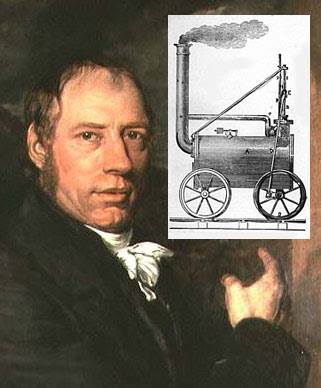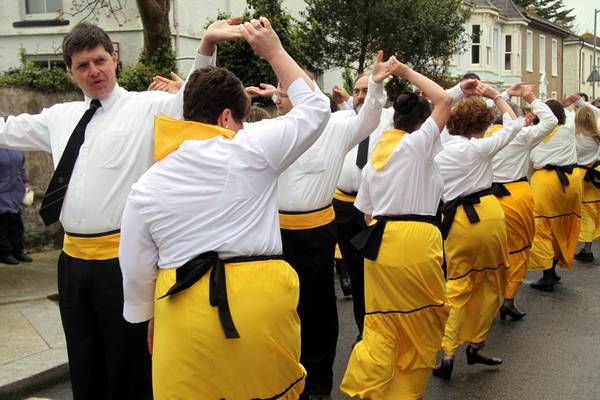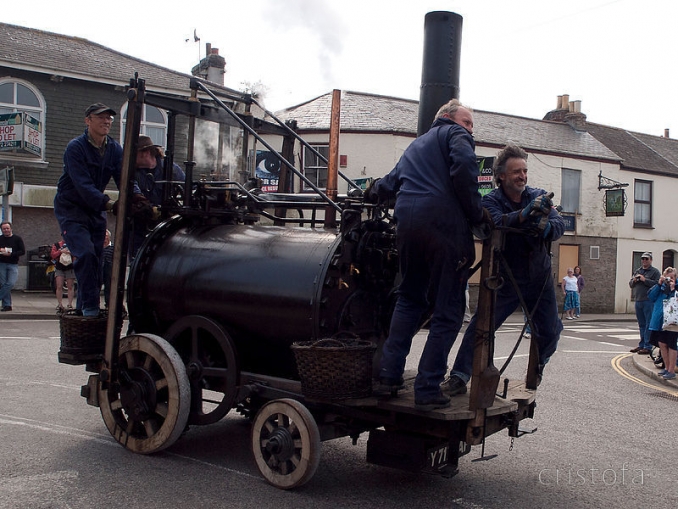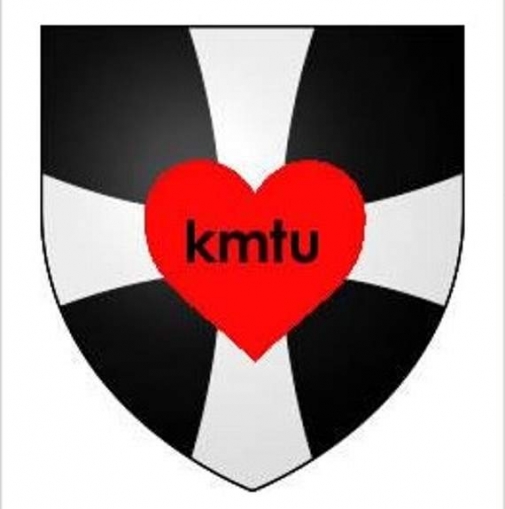Trevithick Day, Camborne - Saturday 28th April, 2018
Saturday 28th April, 2018 will again see thousands flock to Camborne to celebrate Richard Trevithick, that great Cornish engineer so sadly neglected by the British Parliament in 1828, as has been and still is usual in their handling of Cornwall and Cornish matters. But we celebrate despite their governments aim to subsume us as part of their bland greater England project so desired by the Rt Hon Sajid Javid MP.
Here is the great man's story:
Richard Trevithick, was born in Illogan, Cornwall, in 1771.
Richard was educated at Camborne School but he was more interested in sport than academic learning. Trevithick was six feet two inches high and was known as the Cornish giant. He was very strong lad and by the age of eighteen he could throw sledge hammers over the tops of engine houses and write his name on a beam six feet from the floor with half a hundredweight hanging from his thumb. Trevithick also had the reputation of being one of the best wrestlers in Cornwall.
Trevithick went to work with his father at Wheal Treasury mine and soon revealed an aptitude for engineering. After making improvements to the Bull Steam Engine, Trevithick was promoted to engineer of the Ding Dong mine at Penzance.
While at the Ding Dong mine he developed a successful high-pressure engine that was soon in great demand in Cornwall and South Wales for raising the ore and refuse from mines.
Trevithick also began experimenting with the idea of producing a steam locomotive. At first he concentrating on making a miniature locomotive and by 1796 had produced one that worked. The boiler and engine were in one piece; hot water was put into the boiler and a redhot iron was inserted into a tube underneath; thus causing steam to be raised and the engine set in motion.
Richard Trevithick now attempted to produce a much larger steam road locomotive and on Christmas Eve, 1801, it used it to take seven friends on a short journey. The locomotive's principle features were a cylindrical horizontal boiler and a single horizontal cylinder let into it. The piston, propelled back and forth in the cylinder by pressure of steam, was linked by piston rod and connecting rod to a crankshaft bearing a large flywheel. Trevithick's locomotive became known as the Puffing Devil but it could only go on short journeys as he was unable to find a way of keeping up the steam for any length of time.
Despite these early problems, Trevithick travelled to London where he showed several leading scientists, including Humphrey Davy, what he had invented. James Watt had been considering using this method to power a locomotive but had rejected the idea as too risky. Watt argued that the use of steam at high temperature, would result in dangerous explosions.
Trevithick was later to accuse Watt and his partner, Matthew Boulton, of using their influence to persuade Parliament to pass a bill banning his experiments with steam locomotives.
In 1803 a company called Vivian & West, agreed to finance Trevithick's experiments. Richard Trevithick exhibited his new locomotive in London. However, after a couple of days the locomotive encountered serious problems that prevented it pulling a carriage. Vivian & West were disappointed with Trevithick's lack of practical success and they withdrew from the project.
Richard Trevithick soon found another sponsor in Samuel Homfray, the owner of the Penydarren Ironworks in Merthyr Tydfil. In February 1804, Trevithick produced the world's first steam engine to run successfully on rails. The locomotive, with its single vertical cylinder, 8 foot flywheel and long piston-rod, managed to haul ten tons of iron, seventy passengers and five wagons from the ironworks at Penydarren to the Merthyr-Cardiff Canal. During the nine mile journey the Penydarren locomotive reached speeds of nearly five miles an hour. Trevithick's locomotive employed the very important principle of turning the exhaust steam up the chimney, so producing a draft which drew the hot gases from the fire more powerfully through the boiler.
Trevithick's Penydarren locomotive only made three journeys. Each time the seven-ton steam engine broke the cast iron rails. Samuel Homfray came to the conclusion that Trevithick's invention was unlikely to reduce his transport costs and so he decided to abandon the project.
Trevithick was now employed by Christopher Blackett, who owned the Wylam Colliery in Northumberland. A five-mile wooden wagonway had been built in 1748 to take the coal from Wylam to the River Tyne. Blackett wanted a locomotive that would replace the use of horse-drawn coal wagons. The Wylam locomotive was built but weighing five tons, it was too heavy for Blackett's wooden wagonway.
Trevithick returned to Cornwall and after further experiments developed a new locomotive he called Catch Me Who Can. In the summer of 1808 Trevithick erected a circular railway in Euston Square and during the months of July and August people could ride on his locomotive on the payment of one shilling. Trevithick had plenty of volunteers for his locomotive that reached speeds of 12 mph (19 kph) but once again the rails broke and he was forced to bring the experiment to an end.
Without financial backing, Richard Trevithick had to abandon his plans to develop a steam locomotive. Trevithick now found work with a company who paid him to develop a steam dredger to lift waste from the bottom of the Thames. He was paid by results, receiving sixpence for every ton lifted from the river.
Trevithick found it difficult to make money from his steam dredger and in 1816 he accepted an offer to work as an engineer in a silver mine in Peru. After some early difficulties, Trevithick's steam-engines were very successful and he was able to use his profits to acquire his own silver mines. However, in 1826 war broke out and Trevithick was forced to flee and leave behind his steam-engines and silver mines. After a unsuccessful spell in Costa Rica, Trevithick moved to Colombia, where he met Robert Stephenson, who was building a railway in that country. Stephenson generously gave Trevithick the money to pay for his journey home.
Although inventors such as George Stephenson argued that Trevithick's early experiments were vital to the development of locomotives, in February 1828, the House of Commons rejected a petition suggesting that he should receive a government pension. Trevithick continued to experiment with new ideas. This included the propulsion of steamboats by means of a spiral wheel at the stern, an improved marine boiler, a new recoil gun-carriage and apparatus for heating apartments. Another scheme was the building of a 1,000 feet cast-iron column to commemorate the 1832 Reform Act.
All these schemes failed to receive financial support and Richard Trevithick died in extreme poverty at the Bull Inn, Dartford, on 22nd April, 1833. As he left no money for his burial, he faced the prospect of a pauper's funeral. However, when a group of local factory workers heard the news, they raised enough money to provide a decent funeral and he was buried in Dartford churchyard.
Camborne Trevithick Day - organisational issues
Trevithick Day traditions, absent for several years, will be re-established at this year’s festival.
The children’s Bal Maidens and Miners dance will once again be led by a half-sized engine with miniature engines following the children.
Once more the afternoon dance will be led by a road locomotive with honours going to last year’s winner of the “Stuart Solomon Memorial Cup”, Martin True’s Aveling and Porter Steam Roller. During the winter, Martin’s two sons, Joe and Ben, fitted the roller with a brand new canopy. This will be a poignant and lasting memorial to Ben who has since tragically passed away. Of special interest is Colin Savage’s Garret 4CD Steam Tractor, “Leslie” built in 1929, this remarkable machine has met the challenge of travelling from John O’Groats to Lands’ End. The engine has had a total rebuild, taking eight years to complete.
This year’s programme cover features Martin True’s Aveling and Porter steam roller. Graham Winter, vice-chair and programme editor said “We’ve a bumper issue this year with over forty pages packed with articles and pictures, which makes it a bargain at only a pound! They’ll be on sale throughout the town soon, and on the day.”. The Camborne Piskies Explorer Scouts will be selling them on a profit sharing basis. Those using the Park and Ride will get a complimentary copy.
The AA are signposting the park & ride from the A30 and the Cornwall Bus Preservation Society are providing the buses while the Veor Rugby Club are manning the gate.
The Camborne Trevithick Day Committee are delighted with the response they’ve had regarding the new flags. Steve Kingstone, flag-coordinator, said “We won first place with “Tesco’s Bags of Help” giving us a whopping start of four thousand pounds, grants have come from groups like Camborne Old Cornwall Society, Centenary Arts and the Flower Festival, Camborne Regeneration Forum, and generous donations via crowdfunding Added to this there has been a two thousand pound grant from The Cornwall Heritage Trust. Response from the traders in the town has been tremendous, all have been delighted that their old Christmas tree holders are going to be put to such good use. No one has yet refused us and some have offered donations, while others are installing holders so they can also fly a flag.
We are nearing the capacity of the one hundred flags ordered from the local firm Sailflags of Goldsithney”.
Matching bunting is still available to buy for anyone wishing to decorate their premises. Those still wishing to give something towards the flags can do so by going to
justgiving/crowdfunding.com/trevor_dalley).
Contacts can be found on the website www.trevithick-day.org.uk/take part in trevithick-day
Agan Tavas will be launching their new Cornish language baseball caps on their stall at the event. Look out for them!
Agan Tavas website here: https://www.agantavas.com/caps-with-cornish/
Kernow bys vyken!











